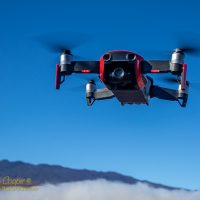OK, I have the FAA rules for operating a drone figured out. What about Canada? As I will be voyaging along the Inside Passage this month I intend to fly in Canadian airspace. The scenery of the wild British Columbia coastline is just too fantastic to pass up, particularly from the air.

Rules for drones in Canada are the responsibility of Transport Canada, the equivalent of the US Federal Aviation Administration. TC maintains a very nice set of web pages covering drone rules and regulations. There is even a nice PDF page that summarizes the rules.
In general Canadian drone rules are much more restrictive than the FAA drone rules. For example the range limits are 90 meters above ground, notably lower than the US 400ft rule. Operation must be at a maximum range of 500m, where the US allows up to visual line-of-sight, potentially several miles.
The Canadian rules are likely to get far more restrictive in the near future. Current drone rules are covered by Interim Order No. 9 Respecting the Use of Model Aircraft put in place earlier this year. the proposed permanent rules include far more restrictive requirement including formal registration with knowledge testing, an insurance requirement, even a prohibition from operating larger drones (>1kg) in “built-up areas”.
The current interim order provides the following rules for drone operation in Canadian airspace…
- Below 90 m above the ground
- At least 30 m away from vehicles, vessels and the public (if your drone weighs over 250 g and up to 1 kg)
- At least 76 m away from vehicles, vessels and the public (if your drone weighs over 1 kg and up to 35 kg)
- At least 5.6 km away from aerodromes (any airport, seaplane base or area where aircraft take off and land)
- At least 1.9 km away from heliports or aerodromes used by helicopters only
- Outside of controlled or restricted airspace
- At least 9 km away from a natural hazard or disaster area
- Away from areas where its use could interfere with police or first responders
- During the day and not in clouds
- Within your sight at all times
- Within 500 m of yourself
- Only if clearly marked with your name, address and telephone number
One restriction that gave me pause was the prohibition from flying near a vehicle or vessel. I was planning to fly from a vessel! In this case the Nordic Quest would be my launching platform. While the summary web pages simply stated “..at least 76 m away from vehicles, vessels…” going to the actual text of the interim order provided clarification.

The “restricted airspace” part will take a bit more work. For pre-flight airspace rules checks I will be using AirMap. I have found the application very useful in checking airspace status, plus it covers Canadian airspace as well as the US.
OK, got it… Need to mark the drone with contact information… Ready to fly! That 500m range thing is going to be a problem, but not much for it. Just need to reset the drone software for the new limits and to use metric in the on-screen readouts when I cross the border.


Did u put floats on it in case of a water landing? Hope u had fun. We wait with baited breath for the videos.
Aloha